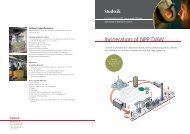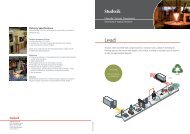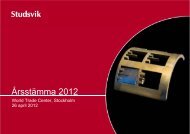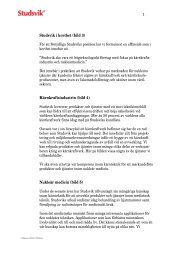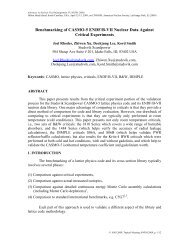Robust PCI Monitoring During PWR Operation at ... - Studsvik
Robust PCI Monitoring During PWR Operation at ... - Studsvik
Robust PCI Monitoring During PWR Operation at ... - Studsvik
- No tags were found...
Create successful ePaper yourself
Turn your PDF publications into a flip-book with our unique Google optimized e-Paper software.
Proceedings of 2010 LWR Fuel Performance/TopFuel/WRFPMOrlando, Florida, USA, September 26-29, 2010Paper 097Pins with the lowest margin during the event are fromthe same assembly loc<strong>at</strong>ions in which the lead control bankwas partially inserted during the event. These assemblieshave pin exposures high enough th<strong>at</strong> the fuel/clad gap isexpected to have closed prior to the event.Furthermore, using these thorough and rigorousmethods, it has provided confidence th<strong>at</strong> the fuel failureexperienced during the open valve test in the SouthernNuclears <strong>PWR</strong> was not caused by <strong>PCI</strong>. This analysishelped elimin<strong>at</strong>ed this potential cause from any furtherinvestig<strong>at</strong>ion and has allowed Southern Nuclear to focusresources onto other potential sources of fuel failure. (Rootcause analysis results based on poolside inspectionsconducted by Southern <strong>at</strong> the end of cycle turned out to beconsistent with results from these studies.)The techniques presented in this study were applied toanalyze a past oper<strong>at</strong>ing event, but they can also easily beapplied to the simul<strong>at</strong>ion of a future power maneuvers toassess margin to fuel performance parameters (such as cladstress, strain) before the event actually occurs. The resultscould then be used to alter the power maneuver, ifnecessary, to ensure sufficient margin and help reducepotential fuel failures.Fig. 9. Minimum margin to clad yield stress (lead controlbank partially inserted)The results indic<strong>at</strong>e there is still a large degree ofmargin before fuel failure would occur, even for the mostlimiting pin loc<strong>at</strong>ions during this event. (Fuel failure mightstill be possible due to prior mechanical damage th<strong>at</strong> couldhave been exacerb<strong>at</strong>ed during this event; missing pelletsurface, introduction of foreign m<strong>at</strong>erial hitting the fuelpin, hydriding, etc.)VI. CONCLUSIONThree different methodologies to evalu<strong>at</strong>e fuelperformance in terms of <strong>PCI</strong> were applied to an actualtransient from oper<strong>at</strong>ing <strong>PWR</strong>. The methods range fromexamining changes in coarse nodal LHGR's (delta-kW/ftmodel) during the transient as an indic<strong>at</strong>or of <strong>PCI</strong>susceptibility, to a threshold-based pin-by-pin model, tothermo-mechanical fuel performance analysis for every pinin the entire core.The work here demonstr<strong>at</strong>es th<strong>at</strong> all three approachesare comput<strong>at</strong>ionally feasible and th<strong>at</strong> limit<strong>at</strong>ions ofperforming coarse analysis using nodal LHGR d<strong>at</strong>a (inwhich the margin to <strong>PCI</strong> is underestim<strong>at</strong>ed) can bereplaced with explicit pin-by-pin thermo-mechanical fuelperformance evalu<strong>at</strong>ion during plant oper<strong>at</strong>ion.The coupled CMS-ENIGMA analysis hasdemonstr<strong>at</strong>ed how an explicit pin-by-pin <strong>PCI</strong> analysis canbe applied during actual oper<strong>at</strong>ing events for fuelperformance assessment.NOMENCLATURE<strong>PCI</strong> – Pellet Clad InteractionLHGR – Linear He<strong>at</strong> Gener<strong>at</strong>ion R<strong>at</strong>e<strong>PWR</strong> – Pressurized W<strong>at</strong>er ReactorDelta-kW/ft – delta kilow<strong>at</strong>t per foot (energy)SCC - Stress Corrosion CrackingBOC – Beginning of CycleHFP – Hot Full PowerMTC – Moder<strong>at</strong>or Temper<strong>at</strong>ure CoefficientCMS – <strong>Studsvik</strong> Core Management SystemkPSI – kilo-pounds per square inch (pressure)MPa – mega Pascals (pressure)GWd/T – gigaw<strong>at</strong>t days per metric ton (exposure)REFERENCES1. J. D. RHODES, K. S. SMITH, J. D. LEE,“CASMO-5 Development and Applic<strong>at</strong>ions,”PHYSOR 2006, Vancouver, Canada, (Sept 2006).2. K.S. SMITH et al., “SIMULATE-3 Methodology,”<strong>Studsvik</strong> Report, SOA-95/18 (1995).3. A. DIGIOVINE and A. NOËL, “GARDEL-<strong>PWR</strong>:<strong>Studsvik</strong>’s Online <strong>Monitoring</strong> and ReactivityManagement System,” Proceedings of Advances





